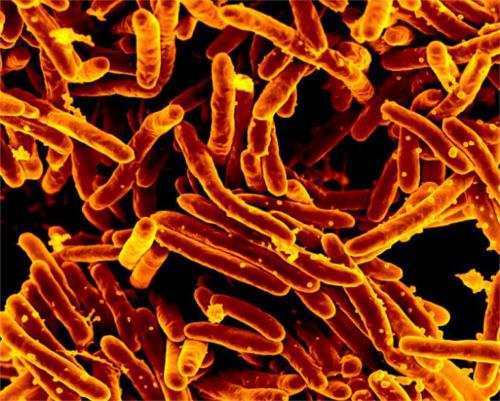One-month tuberculosis prophylaxis as effective as nine-month regimen for people living with HIV
A one-month antibiotic regimen to prevent active tuberculosis (TB) disease was at least as safe and effective as the standard nine-month therapy for people living with HIV, according to the results of a large international clinical trial. Adults and adolescents in the trial were more likely to complete the short-course regimen — consisting of daily doses of the antibiotics rifapentine and isoniazid for four weeks—than the standard nine-month regimen of daily isoniazid.

Scanning electron micrograph of Mycobacterium tuberculosis, the bacteria that cause tuberculosis.
The Phase 3 clinical trial, called ACTG 5279, was sponsored by the National Institute of Allergy and Infectious Diseases (NIAID), part of the National Institutes of Health, and conducted by the NIAID-funded AIDS Clinical Trials Group (ACTG). Richard E. Chaisson, M.D., professor of medicine, epidemiology and international health at Johns Hopkins University and co-chair of the trial, presented the findings March 5 at the 2018 Conference on Retroviruses and Opportunistic Infections (CROI) in Boston.
“Globally, tuberculosis kills more people than any other infectious disease, and it is the leading cause of death for people living with HIV,” said NIAID Director Anthony S. Fauci, M.D. “These results have the potential to dramatically change clinical practice by offering people living with HIV who are at risk of developing active tuberculosis an additional, shorter-duration prevention option that is safe, effective and more convenient. This study also will inform future research on prevention of tuberculosis disease among HIV-negative people at risk for developing active tuberculosis.”
Worldwide, TB is the most common serious opportunistic infection in people living with HIV. In 2016, TB accounted for 40 percent of deaths among people living with HIV, according to the World Health Organization (link is external) (WHO). An estimated one-quarter of the world’s population has latent TB infection. A person with latent TB has been infected with tuberculosis-causing bacteria but does not have any symptoms of the disease. Among people with latent TB infection, HIV infection is the greatest risk factor for progression to active TB disease. Skin or blood tests can detect latent TB infection, but may not be readily available in resource-limited areas. WHO guidelines (link is external) recommend TB prophylaxis for adults and adolescents living with HIV who have either had a positive test for latent TB or have an unknown TB status and who do not have active TB.
Prophylactic antibiotic therapy to stop active TB from developing is effective, but current preventive regimens are lengthy, can be difficult for people to complete, and carry the risk of side effects such as liver damage. A six- to nine-month course of daily isoniazid has been the standard in many TB-endemic countries, although WHO recommendations include different options ranging up to to 36 months in length for people living with HIV. Prior preclinical studies had suggested that an ultra-short course of treatment may be as effective as a longer regimen. Researchers suspected that it also may increase treatment adherence.
Between 2012 and 2014, the ACTG 5279 study enrolled 3,000 people 13 years of age and older living with HIV in Botswana, Brazil, Haiti, Kenya, Malawi, Peru, South Africa, Thailand, the United States and Zimbabwe. All participants either lived in an area with a high TB burden or had had a skin or blood test indicating latent TB infection. When they entered the study, approximately half of participants were taking antiretroviral therapy to treat their HIV. At the time of study enrollment, decisions on when to start antiretroviral therapy typically were based on a person’s CD4+ cell count—a measure of immune system health. Current WHO guidelines recommend that all people living with HIV begin antiretroviral treatment as soon as possible after diagnosis, regardless of CD4+ cell count.
Study participants were randomly assigned to a one-month course of rifapentine and isoniazid or a nine-month course of isoniazid. Investigators monitored the participants for an average of three years.
Overall, TB incidence was lower than expected and was similar in both treatment arms, with 32 participants assigned to the one-month regimen and 33 to the nine-month regimen developing active TB disease. Regardless of treatment type, TB rates were higher among participants who were not on antiretroviral therapy at the start of the study and among those who had had a positive TB skin or blood test. For participants with low CD4+ cell counts—indicating an immune system weakened by HIV infection—at the start of the study, more cases of active TB occurred among those receiving the short-course treatment compared to the standard regimen. However, this difference was not statistically significant, meaning it might have been due to chance.
Both preventive regimens were safe, with fewer adverse events occurring in the one-month treatment arm. Possible side effects of both rifapentine and isoniazid include nausea, vomiting, liver problems and skin rashes. Isoniazid also can cause numbness and tingling in the extremities. People living with HIV may be particularly prone to experiencing these side effects.
Treatment adherence was significantly better for the shorter regimen. Nearly all (97 percent) of those assigned to the short-course therapy completed the full antibiotic course, compared to 90 percent of participants in the nine-month arm.
“Compared with standard tuberculosis preventive therapy for people living with HIV, this short-course therapy is similarly safe and effective but reduces treatment time from nine months to one,” said Dr. Chaisson. “This ultra-short course therapy could become an important tool to control HIV-related tuberculosis and has the potential to transform global tuberculosis control efforts.”
Source: U.S. National Institutes of Health
- 279 reads
Human Rights
Ringing FOWPAL’s Peace Bell for the World:Nobel Peace Prize Laureates’ Visions and Actions

Protecting the World’s Cultural Diversity for a Sustainable Future

The Peace Bell Resonates at the 27th Eurasian Economic Summit

Declaration of World Day of the Power of Hope Endorsed by People in 158 Nations

Puppet Show I International Friendship Day 2020

